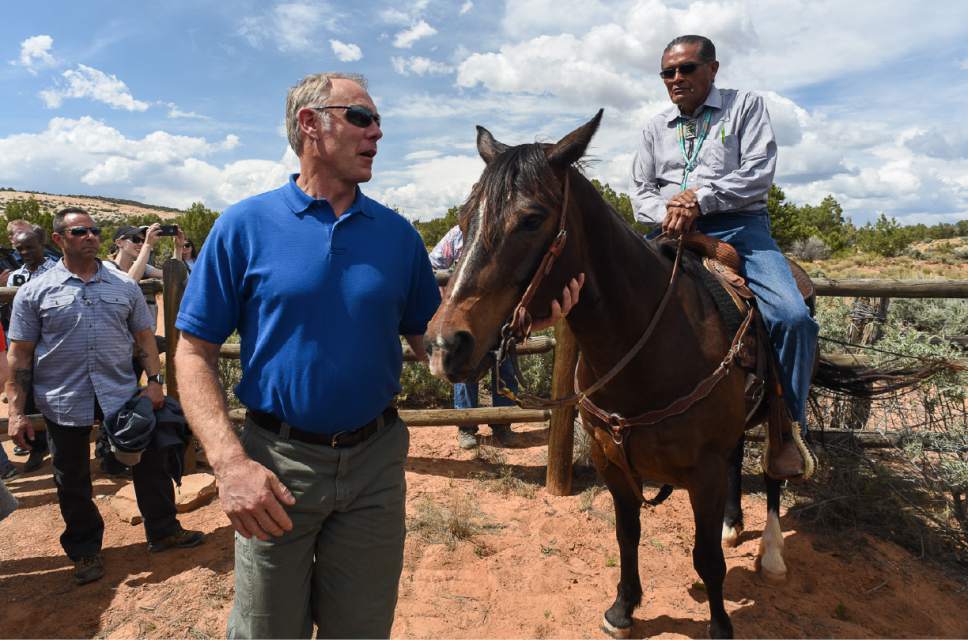This is an archived article that was published on sltrib.com in 2017, and information in the article may be outdated. It is provided only for personal research purposes and may not be reprinted.
Last month, President Trump signed an executive order calling for the Department of Interior to review 56 of the most recently designated national monuments. These national monuments, designated under the 1906 Antiquities Act, aim to protect lands with natural, historic or scientific significance.
Trump vows to do something that has never been done before, kill protection for these significant places. The current review could open the door to transferring these lands out of the national public trust, and into state, private, or individual hands.
Preservation evokes economic insecurity in areas of the West historically dependent upon resource extraction, however the economic diversification that national monuments create offers a solution to economic anxiety.
For example, Utah's Bears Ears National Monument — recently designated by President Obama — is being reconsidered under Trump's review as some push to open the area to coal development. Yet, busting trends in the Four Corners region have placed three coal mines and numerous coal power plants in turmoil. Within the next few years, even more coal power plants are predicted to shut down.
There are less than 10,000 coal jobs in Western states combined. The nation as a whole has lost over 60,000 coal jobs in the last six years. Local economies must diversify. One way of doing this is to promote recreational activities in scenic areas. National monuments offer such an opportunity.
In the past year, coal usage was surpassed by natural gas for the first time since the Industrial Revolution, and the trend is only continuing. Economies that have relied on the coal boom are going bust with their main source of income dying.
The most recent Western boom, in the 1990s and early 2000s, was not a result of natural resource extraction, but was a result of the stunning landscapes and close proximity to outdoor recreation. Because of this, Western economic infrastructure has shifted, resulting in diversified economies.
With the freedom of economic diversity, most Western states' GDP no longer rely on mining. Outdoor recreation now employs 6.1 million people nationally, and supports one of the fastest growing job markets in the West.
The battle over recreation and environmental preservation of our public lands is a major issue for the millions of Westerners who live in close proximity to scenic trails and unspoiled forests. The rural Western U.S. contains most of the nation's federal lands, totaling almost 226 million acres from Montana to Arizona. These are lands that support hunting, fishing, hiking, rafting, climbing and unlimited opportunities for diversification of the economy from outdoor recreation. Overlapping much of these federal lands is also a cauldron of pristine headwaters, ecosystem services and rich minable geology. Much of the federally owned lands in the West were protected with the dual intention of protecting consumptive uses, like extraction, and non-consumptive uses, like recreation.
Recreation is currently at an all-time high, and rising. Parks bring millions of visitors from around the nation and the world, booming local economies. Towns like Moab, that were originally settled for cattle ranching and farming until the 1950s uranium boom and bust, are now alive and well because of outdoor recreation. Recreation opportunities support local jobs in outfitting, guiding, lodging and bring people to town. Recreation also supports a growing equipment industry in regional hubs like Salt Lake City, Denver and Boulder.
With increasing political tension, National Monuments such as Bears Ears need to be seen as a way to diversify local economies in the West instead of sinking into the continuous boom and bust cycles we've seen around the West for over a century. The coal market is dead, while public recreation is sprouting green.
Signed by Alexander Lee, Ph.D., and Sarah Rogers, faculty members of the Environmental Studies Program at the University of Colorado, Boulder, and by environmental studies students Kristina Cowell, Becca Ingwers, Jordan Erdie and Kenny Prior.



